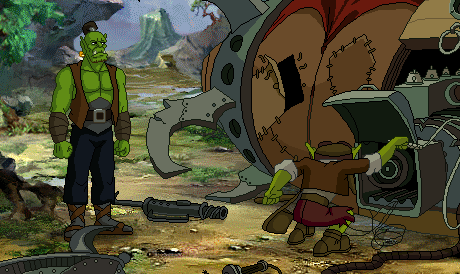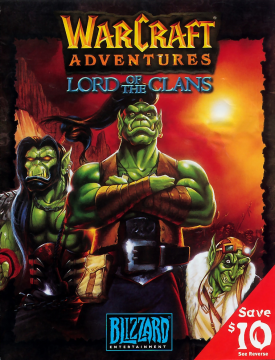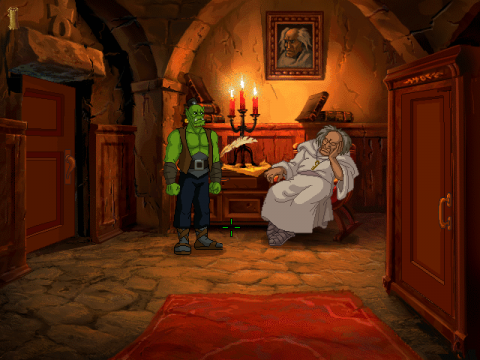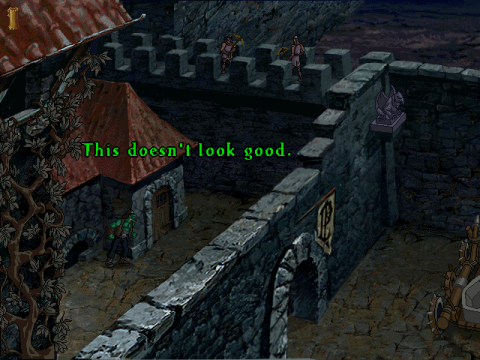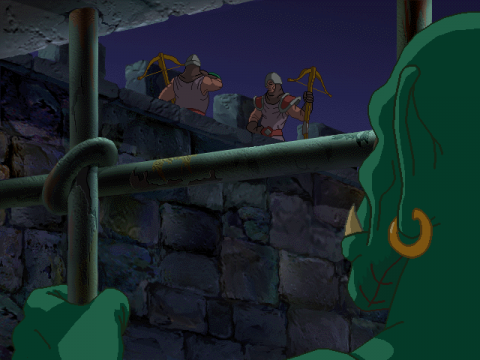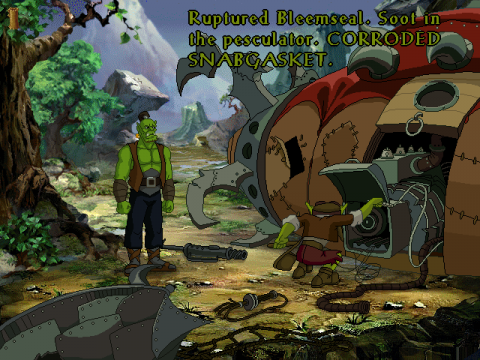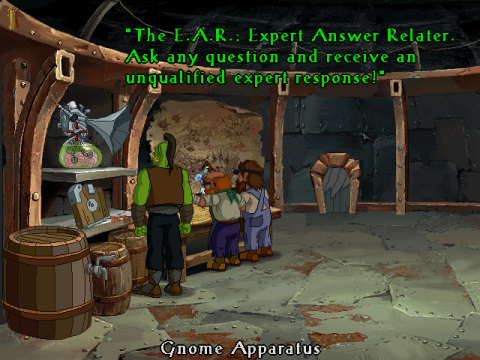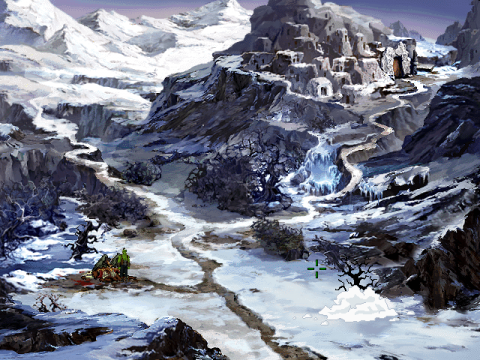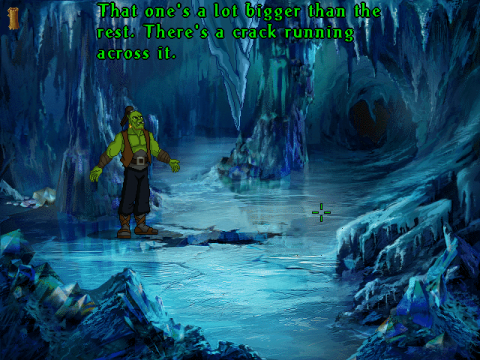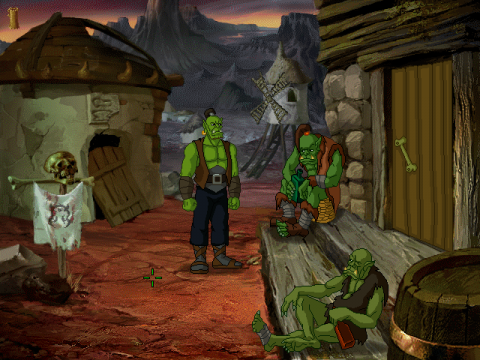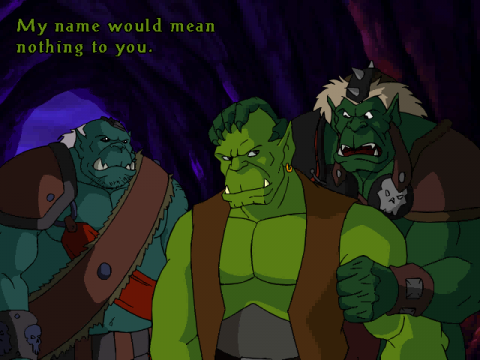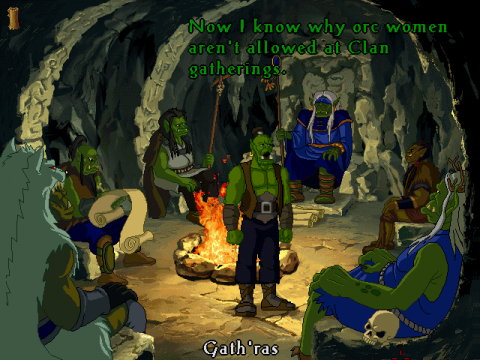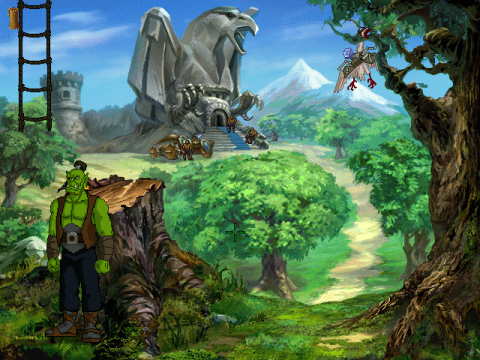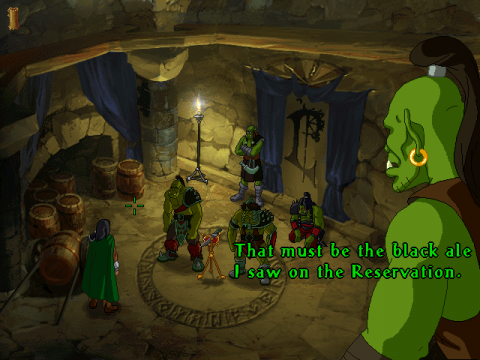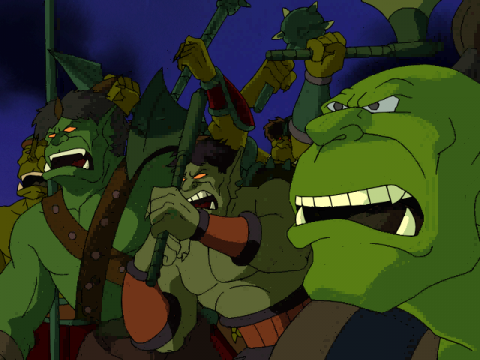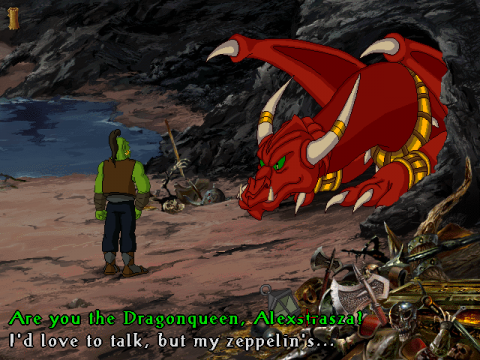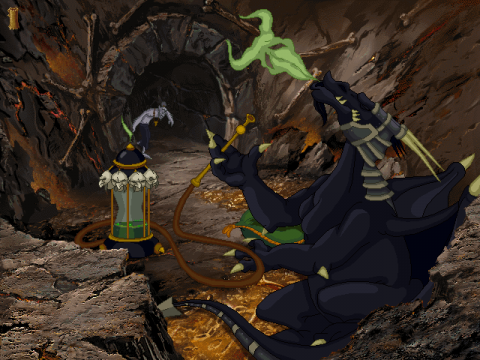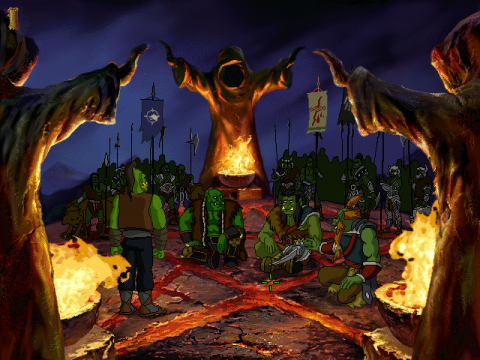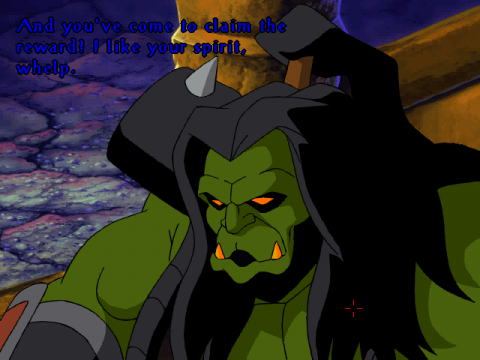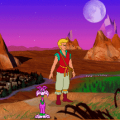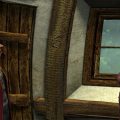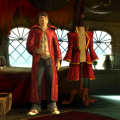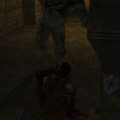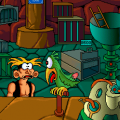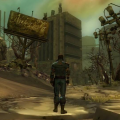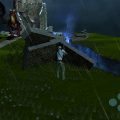Canned amidst distress in Blizzard’s growing fanbase right before E3 1998, Warcraft Adventures: Lord of the Clans was always thought to be a lost chapter in Warcraft history, spawning wistful retrospectives every few years (see extensive Gamespot post-mortem). It is responsible for the introduction of Thrall, now a beloved Warcraft standby, and the questionable embellishment of many others – including the commonly cited Deathwing a la Alice in Wonderland. It would survive in a 2001 novelization (written by Christie Golden of Star Trek pulp fame) designed as a lead-up to Warcraft III, and in the latter Thrall would get a starring role in his first full-fledged game. But Warcraft Adventures remained a routine topic of speculation for a generation of gamers, egged on by a near-complete video longplay that emerged in 2010.
It has now been sent to us confused and aimless like Moses down the river, thanks to another Blizzard enthusiast based in Russia, who briefly leaked a playable copy in early September 2016. The game’s near-two decade interregnum has transformed it from a possibly mediocre title to an intriguing jaunt into its creators’ minds and their evolution as a company. And it is with a certain giddiness many a gamer will delve into the experience, for Warcraft Adventures may be the most polished game ever to be canceled.
Which isn’t to say that it’s the bizarro-world sleeper hit that many fans of the series have always wished it to be – or that it’s even easy on the eyes. From the stuttering, unfinished cutscenes to the robotic voices that occasionally stand in for unrecorded lines, it is decidedly rough around the edges. But unlike the fleeting JPG images, demo clips, and notepad sketches, fans are usually stuck chasing in the aftermath of a big cancellation, Warcraft Adventures is there, (almost) all there – if you can get your hands on it.
Background
Long before World of Warcraft, Azeroth was little more than a cheeky backdrop for the up-and-coming Blizzard Entertainment (previously Silicon & Synapse) to launch their breakthrough game. Today known for its beautifully-rendered, expansive world, reams of celluloid, lore & history, and even a feature-length film, Azeroth then was a juvenile, silly place that pit stoic medieval humans against a grunting green menace.
But sometimes it feels good to be bad: and in a gaming trend that would find momentary in vogue in ’90s games like Dungeon Keeper, Blizzard built their fantasy franchise largely around the cartoonish allure of the monstrous Horde, allowing players to face off with their sapien opponents alone or, crucially for the time, online through direct connection with friends.
Warcraft: Orcs & Humans hit the market at a time when real-time strategy was the uncontested province of the Dune franchise, property of Westwood Studios. By 1994, when Warcraft first became available, players were still reeling from the frantic mix of real-time tactical combat, base-building, and resource collection that Dune II had pioneered just two years earlier. And despite being essentially a streamlined (though heavily innovated) clone, Warcraft helped solidify the terms of the genre, permanently earning the newly-crowned “RTS” a seat at the table. Its commitment to online multiplayer (at a time when not every developer could be convinced that the feature was anything more than a cumbersome novelty) further set the series apart, eventually resulting in the well-known Battle.net system as the series evolved.
After a few more years of back-and-forth between Westwood and Blizzard that pushed the incipient form to new heights with the likes of Command & Conquer and Warcraft II respectively, Blizzard saw itself at a crossroads. No stranger to sudden shifts in style – this is the company that brought us The Lost Vikings (1992) and Rock n’ Roll Racing (1993), after all – these self-proclaimed LucasArts devotees thought to throw their lot in with the falling star of adventure gaming with a similar, fully-animated game of their own. And so Thrall & his righteous, euphemistic struggle for orc sovereignty were born, and Blizzard’s efforts were hailed by enthusiastic onlookers as the “cure for the genre’s current doldrums“.
The Looks
As always, Blizzard wanted to make their mark: Thrall’s debut would be animated (always a controversial decision). But at the time, production of Diablo was already in full gear, and Starcraft was no longer a mere glint in designer Chris Metzen’s eye. To give their already-overstretched staff breathing room to concentrate on other franchises, Blizzard made the historically-ironic step of contracting Russian studio Animation Magic to handle the visuals. Ironic, of course, because of Animation Magic’s unbecoming track record with the infamous Zelda CD-I games.
And yet, aside from the cutscenes, which still suffer from the kind of wobbly unevenness that made Animation Magic notorious (and which ultimately had to be redone), the atmosphere in Warcraft Adventures can be remarkably compelling. From wistful wintry tundras to unseemly, fleshy dragon innards depicted with unctuous detail, this is no Wand of Gamelon. And though some characters suffer from blob-like in definition, they are usually capable of creative expression – sometimes bordering on the disturbing, and in others, downright softcore.
Thrall’s animations tend to be the most tightly drawn, and rightfully so, since he takes up the most screentime. On the opposite end of the spectrum are the game’s fauna: from Wendigos to the fearsome Alexstraza herself, these beasts are almost universally hideous – and not in the evocative sense, but in the sense that their creepy undulating makes you want to move on to the next screen posthaste. None of this is helped by the low-FPS stuttering, graphical glitches, and “conspicuously light patches” which pepper the landscape either, adding to the feel of a drive-in B-movie rather than an epic phantasy sojourn for the ages.
Of course, any work self-consciously made in homage to a whole era risks tipping over the line between artful flattery and pandering. Perhaps a still greater sin, given a star-studded cast of voice actors that boasted Clancy Brown (Buckaroo Banzai), Peter Cullen (Optimus Prime), and Tony Jay (MegaByte), is that many scenes in Warcraft Adventures are only partially embellished with dialogue.
Cutscenes may indeed be the one exception, if you can make it through their atrocious jittering – and some fans are thankfully already hard at work fixing this. But beyond flat-out missing lines, many initial dialogue trees reveal no depth upon revisiting. There is nothing quite as deflating as an NPC that hasn’t changed in later acts when you, the eager adventurer, have so very much. And Thrall’s obstinate replies of “uh-uh”, “I see nothing special”, and “I’d rather starve” to almost anything in sight only serve to remind players of the lost potential to make Warcraft Adventures into a living, breathing gameworld. This is the bread & butter of adventure and RPG gaming, so when it’s lacking it is impossible to miss.
The Game
Fans of point-and-click adventures will be familiar with Warcraft Adventures‘ straightforward mechanics: pick up doodads, talk to people, try giving them thingamajigs and hope you get other gewgaws in return – and when in doubt, click on everything.
In the best adventure games, these mechanics flow naturally from the story, mimicking the kind of real-world ingenuity and improvisation that leads to actual problem-solving – albeit in an entirely contained and linear environment. In the worst, they are abysmally obtuse and mix the exactly wrong volumes of theme and abstraction: Old Man Murray’s infamous rant on Gabriel Knight and the “death” of adventure games being a case in point.
Warcraft Adventures finds itself somewhere in the middle: for much of the first half of the game, puzzles tend to flow nicely, if rather simply, and don’t strain credulity. In order to escape Blackmoor’s stronghold, Thrall must don some sort of disguise; the decadent Chaplain Mathers, sound asleep in his chambers, begs for his wardrobe to be pilfered. A bit later, a Zelda-style (or maybe Craigslist-style) trade quest leads to meeting Grom Hellscream himself, with players trading up from crude ale to a powerful tome of ogrish magic in a fairly logical chain. No part of these sequences feels forced – though they are chock full of derivative bits, from age-old “reflected lightning” puzzles to the familiar “distract and replace” scam.
But the well tends to run dry further into the game, and the glorified lock-and-key mechanics that undergird the entire genre begin to lose their initial luster. More than one player will find themselves throttling the monitor, for example, when it turns out that hours were wasted (and FAQs resorted to) because the spell they tried to cast was meant to be clicked on Thrall, not its logical target (like every other spell in the game). Or that the most obvious way to break through something is through an elaborate, indirect scheme involving a narcissistic monster, and not…you know, breaking it. With anything.
Furthermore, there is a lack of overarching purpose stringing puzzles together, leaving players with an inventory full of pointless stuff – and not the funny kind. Monkey Island would classically toy with the conceit of being forced to look at a dry laundry list of items by filling it with pithy one-liners and bizarre curios: the rubber chicken, the “red herring”, and so on. Here, many items do not manifestly have a purpose until they are called for; or conversely, sit there uselessly after a single puzzle.
One gets the sense that the team behind Warcraft Adventures was grasping for straws towards the end. And one need look no further for proof than their invitation to Steve Meretzky, of A Mind Forever Voyaging and The Hitchhiker’s Guide to the Galaxy renown, for a “fresh set of eyes” to improve and tighten up the gameplay in the terminal velocity of its final days.
What Happened
According to Bill Roper, producer for Warcraft Adventures, Meretzky came on board for an intensive, two-week redesign process which saw the designers locked up in the company’s “tower” for “marathon sessions” of up to 14 hours a day. The changes were welcome, it seems, but the amount of work it would have taken to retool the game to the new schematic was daunting. For a game this late in development, it would have required re-recording lines, redrawing several sequences, and more delays – something usually right up Blizzard’s alley.
But by the end of 1997, The Curse of Monkey Island and Broken Sword II: The Smoking Mirror had been released. Both pre-empted Warcraft Adventures with refreshing (and more professional) animated styles, but only Broken Sword II performed well commercially. Along with the looming specter of Grim Fandango, which looked to be going to the “next level of adventure games”, the picture looked very…well, grim. The sentiment among the team, according to Roper, was that the game “would have been great three years ago”. And so the decision was ultimately made to can Warcraft Adventures and refocus Blizzard’s energy on other projects.
Many have interpreted the decision as proof of Blizzard’s fidelity to a good product, and their willingness to cancel a game late in development to protect the quality of their brand. The designers themselves share this view and have favorably cited Starcraft: Ghost, along with the lesser-known Pax Imperia 2, Shattered Nations, and the unfortunately-titled “Games People Play” as some examples of this philosophy.
But for a company that has been so adamant about creating its own market and defying “market data”, it’s a quixotic move. For example, in a 1997 interview about the game in PC Gamer, Roper was quoted as saying that RPGs were considered dead before Diablo only because developers weren’t “doing enough with them”. And this seems to fit with Blizzard’s general mantra, at least historically: make the games you want to play. Yet in the aforementioned post-mortem, Roper claimed that gamers were simply not “voting with their dollars” for adventure games, showing the company that they were barking up the wrong tree.
Truthfully, as Mike Morhaime (president & co-founder of Blizzard) has indicated, it was as much a numbers game as anything about game quality: if something as well-made as Curse of Monkey Island (and as we would eventually learn, Grim Fandango) could flop, so could Warcraft Adventures, which was struggling as it is. So it wasn’t that Blizzard simply wasn’t happy with the game; it’s that the prospect of a lost investment did not motivate them to apply their characteristic rigor, which may very well have made the difference between a merely acceptable and a stellar product.
It is also very probable that the version available to us doesn’t even include the Meretzky tweaks. Indeed, according to a Twitter exchange with the typically bombastic Mark Kern, former Blizzard team lead for World of Warcraft, the Meretzky version never got very far. And while we may do well to take Kern’s words with a grain of salt – he wasn’t even around at the time – it seems to fit with the narrative we’ve received from others who were actually involved with the project. Who knows if the Meretzky version could have sharpened the game’s focus, and stripped it of the trans-misogyny and dick jokes to leave room for some authentically black humor instead.
The answer may appear obvious – that Blizzard simply didn’t feel that their game was playable; that for it to burst out onto the scene and make a splash, it had to be compellingly different. But the hype was high and the Warcraft brand was still relevant – there’s no telling where it could have gone. If the namesake of the series proved anything, it’s that a straightforward homage can absolutely hit a sweet spot.
It is, perhaps, another elliptical argument. And it is true that sometimes, it is best to let a struggling project die a quiet death rather than march it to ignominious release. But there’s enough there to see that Warcraft Adventures may have had a future – fans certainly were clamoring for it at the time, even circulating a petition within hours of the cancellation announcement that got big enough to warrant a response from the company. Still, faced with uncertainty, Roper and his team stuck with their decision, channeling the storyline into the paperback edition and Warcraft III: The Frozen Throne.
The Caveat
Whether released in 1994 or 1998, however, Warcraft Adventures’ biggest failing may actually have nothing to do with its mechanics per se. For a game so invested in working out, in Roper’s words, “what makes the orcs tick“, it spends an awful lot of time not being sure about the very same. In Thrall and his one-dimensional companions, we are offered yet another cheap cocktail of “war-like” Viking and magical Native American tropes that supposedly satisfy the threshold of believable depth for a story in Fantasy subcultures.
And the comparison is not a stretch: in his travels, Thrall comes across orc encampments quite literally referred to as “reservations” (“internment camps” in the book, evoking another frightful story of World War II Japanese-American camps) in which once-mighty orcs now shamefully drown themselves in drink. The themes of alcoholism, poverty, and malaise in indigenous America are not new; the real-life controversy over legalizing alcohol on the Pine Ridge reservation (which it eventually did in 2013) is one example reminding us that this “theme” is in fact a real-world struggle.
Like a soap opera, Warcraft Adventures endlessly riffs on its core themes until they’re run through the ground, from the pulpy backstories of Azeroth’s many clans to the false gravitas of a “noble…expansionist and very military” race (in Roper’s own words, evoking another old and uninterrogated concept, the “noble savage”). Never mind the much-abused concept of the “shaman”, a word with Siberian origins transplanted onto Western indigeneity, but which features prominently in Thrall’s conception as a character and indeed in the Warcraft universe as a whole. Narrative elements are handled with Highlander-like imprecision, as this hazy tale takes itself seriously in all the wrong places; where it could at least use a bit of self-conscious ribbing, it leans on the house of cards that is its theme, and where it could use some introspection, we get dismal one-liners.
Ultimately, the whole premise of this style of fantasy writing is to revel in the quaint, romanticized primitivism of its protagonists – so it is perhaps unsurprising that the series has sparked little discussion about the real-world inspiration for everyone’s favorite green mongoloids, or their own real-world, epic battles for survival, like the Dakota Access Pipeline battle in 2016, shortly after the game was leaked. In all of this, Warcraft Adventures is not exactly unique – but it is certainly as nauseating as any other garden variety fantasy that hasn’t done its homework.
To be fair, it is something of an American tradition to countenance “Indians” in the abstract, but never in life itself. But like most works of art that dip their foot into serious themes, Warcraft Adventures does so coquettishly, as a voyeur, and with no intention of ever jumping all the way in. Some might say this is a good thing; others might say that it is the easy way out. Either way, we have Warcraft Adventures to thank for the dense, pseudo-spiritual mythemes which serve as a backdrop for the whole series. It would be wise, with this in mind, to never mistake convolution for depth.
Conclusion
Despite complaints to the contrary, Warcraft Adventures proves to be a pleasant, if unimpressive foray into the adventure game genre that fleshes out a (problematic) world which up until then had only been a pretense. With the depth & pacing of a Disney knock-off, Warcraft Adventures is far from boring – and where it suffers from literary weakness, it is kept afloat by the imposing tones of its professional cast of television actors.
Indeed, like all of the hopelessly confused TV of today & yesteryear, somewhere in all of its contradictions there is room for a young heart to be inspired. The question, then, is whether one is inspired because or in spite of the thing itself – each and every player will of course have to draw their own conclusions. But one thing is certain: Warcraft Adventures will never leave you truly stumped, and can entertain so long as you take everything with heaping mounds of delicious, chunky kosher salt.
Links:
Gamespot Post-mortem In-depth interview with Bill Roper from 1999 about the cancellation
Warren Spector & Mike Morhaime Lecture Warren Spector lecture series/presentation by president/co-founder of Blizzard, Mike Morhaime, including interview & Q&A
A History of Blizzard Entertainment A Summary of Blizzard’s early efforts
A History of Blizzard IGN History of the company.
A Brief History of Azeroth and the Warcraft Universe IGN’s History of WoW
History of Warcraft – Christopher Demicoli Detailed fan history
Scrolls of Lore leak thread Original thread where Warcraft Adventures was leaked
PC Gamer June 1997 Preview Feature on Warcraft Adventures Full of funny tidbits in retrospect
PC Gamer – The Inside Story of Warcraft Adventures More History, including contemporary citations from MAN-biker (2010 video leak), reidor (2016 leak), Meretzky, and Roper
Scrolls of Lore Screenshots Large album, including development sketches
Warcraft Adventures: Lord of the Clans (Longplay by MAN-biker) Original Longplay, leaked 2011
Warcraft Adventures Cutscene Project Reworking & updating cutscenes
